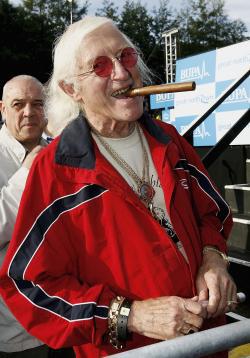Allegations that a popular British TV and radio host sexually abused “at least 200 victims” have thrown the BBC into crisis. Assaults on underage girls by Jimmy Savile, who died last year at age 84, are alleged to have happened on BBC property (as well as at schools and hospitals where he volunteered), and as the New York Times reported this morning, the corporation “failed to investigate rumors or take seriously accusations about his behavior [and] canceled a segment about the allegations that was scheduled to be broadcast last December.” One veteran journalist has described this as “the worst crisis” the BBC has faced in the last 50 years.*
I imagine it’s hard for Americans reading U.S. press coverage to conceive of a scandal involving a glorified DJ wreaking such havoc on an institution as powerful as the British Broadcasting Corporation. It’s no doubt especially difficult after seeing photographs of Savile, who died last year: He wore his peroxided hair in the same bowl cut for 50 years, was usually dressed in a tracksuit and scads of gold jewelry, and he was often seen with a cigar in his mouth.
Strangest of all for a man who was hosted some of Britain’s most popular radio and TV shows for decades, he had an oddly limited vocabulary, which mostly consisted of oft-repeated catchphrases: “How’s about that then,” “As it happens,” and a sort of strangled Tarzan call that launched a thousand impressions. In fact, he was so popular with impressionists that when I was growing up in the 1970s, it felt like he was on television every night of the week.
But even without the imitators, Savile was a perennial presence on the box—in 1964, he was the first host of Top of the Pops, and he made regular appearances until the chart show came to an end in 2006. He also hosted children’s TV shows, most notably Jim’ll Fix It 1974-94, in which kids would write in—apparently as many as 20,000 each week—asking Savile to set up fabulous experiences or visits to famous people, a sort of Make a Wish Foundation for healthy kids. At the height of its success, 15 million people watched the show on Saturday nights.
During World War II, Savile was conscripted to work as a coal miner and suffered a spinal injury as a result of a pit collapse. (He recovered and became a keen sportsman, wrestling semi-professionally and most famously completing more than 200 marathons.) He later became a high-profile philanthropist, raising as much as $65 million for U.K. charities—particularly those related to spinal injuries—during his lifetime. Between his charity work and the Jim’ll Fix It setups, Savile became friendly with the good and the great of British life, including Prince Charles and Margaret Thatcher, with whom he claimed to have spent two Christmases.
This combination of making children’s wishes come true, hosting Britain’s most popular pop music show, and being the nation’s most high-profile philanthropist—and doing so for more than 40 years—gave him an unusually broad platform. It’s unlikely that anyone else will ever have that kind of impact again. Savile established himself as a hard-working eccentric in the days when Britain was still a monoculture, with only one commercial channel challenging the BBC’s TV dominance and very little competition on the radio airwaves.
The BBC is still immensely powerful in British life—and since everyone with a TV set must pay an annual license fee of roughly $230, Britons feel a connection to the corporation unlike anything Americans may feel for, say, PBS. (Sorry, Big Bird.) But there are now dozens of TV and radio channels and, of course, the Internet offering endless entertainment options. Thank goodness, because Savile’s fame and exalted connections are what made his alleged victims—and some of the adults who claim to have witnessed inappropriate contact with young girls—afraid to report him.
* This paragraph has been updated with additional details about the allegations against Savile.
